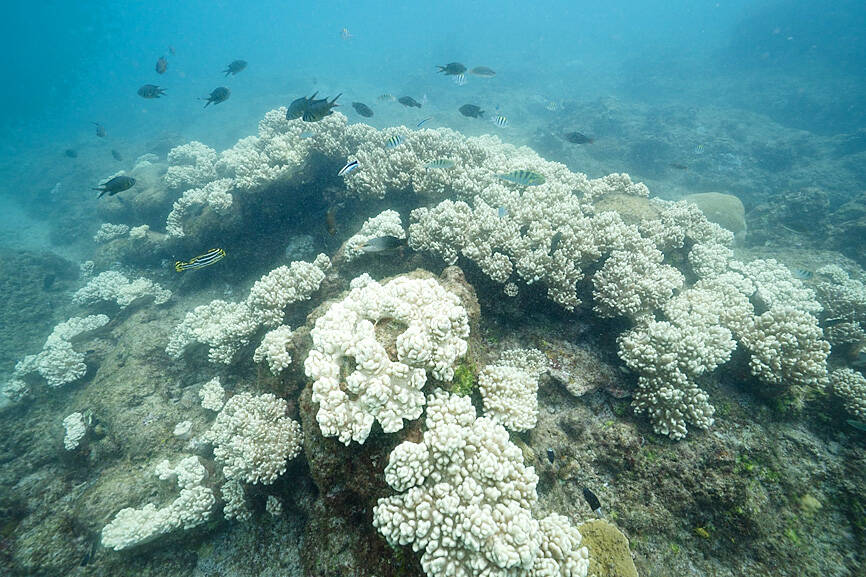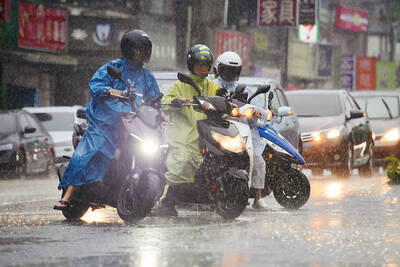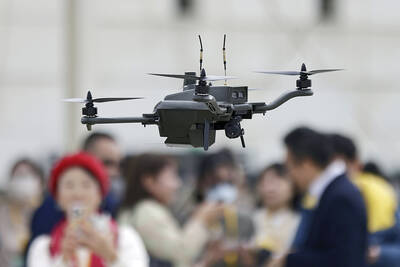Increasing occurrences of hypoxia, or low levels of oxygen in a body of water, are threatening coral in tropical environments, a research paper that a Taiwanese research team contributed to said.
The paper, titled “Increasing hypoxia on global coral reefs under ocean warming,” was published on Thursday on the online journal Nature Climate Change, detailing the results of a study led by the Scripps Institution of Oceanography at the University of California, San Diego.
Chou Wen-chen (周文臣), a professor at National Taiwan Ocean University’ Institute of Marine Environment and Ecology who contributed to the paper, on Saturday said that in the past, hypoxia mostly occurred in temperate seas, but the phenomenon is now being observed in tropical waters.

Photo courtesy of Su Huai
Chou’s team found that five coral reef ecosystems near Taiwan’s Pratas Islands (Dongsha Islands, 東沙群島) and Itu Aba Island (Taiping Island, 太平島) are all in a state of moderate to severe hypoxia.
Teams from Taiwan, Japan, Panama, Puerto Rico and the US studied 32 coral reefs in 12 locations worldwide, observing day-night changes in oxygen levels in the seawater.
“The study clearly reveals that global warming not only aggravates the bleaching of corals and the acidification of oceans due to the increase in dissolved carbon dioxide, but also worsens hypoxia,” Chou said.
The teams used the four climate change scenario models proposed by the UN Intergovernmental Panel on Climate Change (IPCC) to predict how dissolved oxygen levels change due to climate change, he said.
The study showed that by the year 2100, the temperature rise would cause oxygen solubility to decrease, and the oxygen consumption rate of coral’s biological metabolism to increase, which would greatly worsen hypoxia in coral reef ecosystems, Chou said.
However, Huang Wei-jen (黃蔚人), an associate professor at National Sun Yat-sen University’s College of Marine Sciences, said that hypoxia cannot be explained by one factor.
“It is necessary to understand the relationship between hypoxia and other factors, such as rising sea temperatures, accelerated respiration and coastal eutrophication,” he said.
Scientists are looking at ways to stave off bleaching by studying high-temperature-resistant corals, but this would not solve the problem of hypoxia, said Chen Chao-lun (陳昭倫), an associate researcher at Academia Sinica’s Biodiversity Research Center.
“A comprehensive study of what causes bleaching is needed to deal with future changes,” Chen said, adding that the research published on Thursday was the first to study coral reefs in different seas simultaneously, and to confirm hypoxia on a global scale.
The study found that more than 97 percent of the sampling points were in varying degrees of hypoxia, of which 13 percent were severely hypoxic, he said, adding that the points measured near the Pratas Islands and Itu Aba were among the most severely hypoxic samples.
“Under the scenario of extremely high emissions estimated by the IPCC, the number of coral reefs in environments with very low oxygen levels will nearly triple by the end of this century,” Chen said.
Most research focuses on hypoxia in temperate climates, and for organisms that dwell on the ocean floor, he said.
“Also, this study looks at the impact of hypoxia on individual organisms. Whether climate change or increased carbon dioxide emissions increase the impact of hypoxia on the overall coral reef ecosystem requires more research,” he said.
The ocean absorbs a large amount of heat produced by global warming, and dissolves a large amount of carbon dioxide, increasing the possibility of algal blooms, which increase the occurrence of hypoxia in coral reefs, he said.
It is also necessary to avoid polluting the habitats of marine organisms, which could worsen hypoxia through eutrophication, National Museum of Marine Biology and Aquarium researcher Tang Chuan-ho (唐川禾) said.

The combined effect of the monsoon, the outer rim of Typhoon Fengshen and a low-pressure system is expected to bring significant rainfall this week to various parts of the nation, the Central Weather Administration (CWA) said. The heaviest rain is expected to occur today and tomorrow, with torrential rain expected in Keelung’s north coast, Yilan and the mountainous regions of Taipei and New Taipei City, the CWA said. Rivers could rise rapidly, and residents should stay away from riverbanks and avoid going to the mountains or engaging in water activities, it said. Scattered showers are expected today in central and

COOPERATION: Taiwan is aligning closely with US strategic objectives on various matters, including China’s rare earths restrictions, the Ministry of Foreign Affairs said Taiwan could deal with China’s tightened export controls on rare earth metals by turning to “urban mining,” a researcher said yesterday. Rare earth metals, which are used in semiconductors and other electronic components, could be recovered from industrial or electronic waste to reduce reliance on imports, National Cheng Kung University Department of Resources Engineering professor Lee Cheng-han (李政翰) said. Despite their name, rare earth elements are not actually rare — their abundance in the Earth’s crust is relatively high, but they are dispersed, making extraction and refining energy-intensive and environmentally damaging, he said, adding that many countries have opted to

FORCED LABOR: A US court listed three Taiwanese and nine firms based in Taiwan in its indictment, with eight of the companies registered at the same address Nine companies registered in Taiwan, as well as three Taiwanese, on Tuesday were named by the US Department of the Treasury’s Office of Foreign Assets Control (OFAC) as Specially Designated Nationals (SDNs) as a result of a US federal court indictment. The indictment unsealed at the federal court in Brooklyn, New York, said that Chen Zhi (陳志), a dual Cambodian-British national, is being indicted for fraud conspiracy, money laundering and overseeing Prince Holding Group’s forced-labor scam camps in Cambodia. At its peak, the company allegedly made US$30 million per day, court documents showed. The US government has seized Chen’s noncustodial wallet, which contains

SUPPLY CHAIN: Taiwan’s advantages in the drone industry include rapid production capacity that is independent of Chinese-made parts, the economic ministry said The Executive Yuan yesterday approved plans to invest NT$44.2 billion (US$1.44 billion) into domestic production of uncrewed aerial vehicles over the next six years, bringing Taiwan’s output value to more than NT$40 billion by 2030 and making the nation Asia’s democratic hub for the drone supply chain. The proposed budget has NT$33.8 billion in new allocations and NT$10.43 billion in existing funds, the Ministry of Economic Affairs said. Under the new development program, the public sector would purchase nearly 100,000 drones, of which 50,898 would be for civil and government use, while 48,750 would be for national defense, it said. The Ministry of